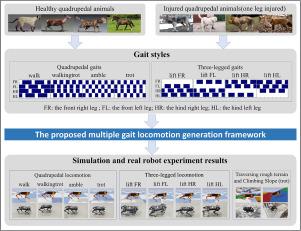Multiple gait locomotion generation for quadruped robots based on trajectory planning and reinforcement learning
IF 4.6
2区 计算机科学
Q1 AUTOMATION & CONTROL SYSTEMS
引用次数: 0
Abstract
Realizing flexible multiple gait locomotion like real quadrupedal animals remains a challenge in the field of quadruped robot motion control. To address this challenge, a multiple gait locomotion generation framework based on trajectory planning and reinforcement learning is proposed for quadruped robots, enabling the generation of various quadrupedal and three-legged locomotion. In this framework, a reference trajectory generator and a trajectory adjustment module are designed. The generator produces the reference trajectory by integrating the policy network, gait temporal information, and foot positions, using a specially designed reference trajectory formula. The adjustment module subsequently refines the trajectory in real time by employing the policy network to adapt the motion to the specific task requirements. The policy network is trained using reinforcement learning in simulation. The proposed framework has been verified both in the simulation environment and on an actual quadruped robot (Unitree A1). Both simulation and physical experimental results demonstrate that the framework enables the quadruped robot to perform a variety of gaits, similar to real animals, including quadrupedal (walk, walkingtrot, amble, trot) and three-legged locomotion (lift any leg). Furthermore, the framework enables the robot to traverse rough terrain and ascend slopes of up to 30 degrees with robustness.

基于轨迹规划和强化学习的四足机器人多步态运动生成
实现像真实四足动物一样灵活的多步态运动一直是四足机器人运动控制领域的一个挑战。为了解决这一挑战,提出了一种基于轨迹规划和强化学习的四足机器人多步态运动生成框架,实现了四足和三足运动的生成。在该框架中,设计了参考轨迹生成器和轨迹调整模块。该生成器利用专门设计的参考轨迹公式,综合策略网络、步态时间信息和足部位置信息生成参考轨迹。调整模块随后利用策略网络实时细化轨迹,使运动适应特定的任务要求。在仿真中使用强化学习对策略网络进行训练。所提出的框架已在仿真环境和实际四足机器人(Unitree A1)上得到验证。仿真和物理实验结果表明,该框架使四足机器人能够执行各种步态,类似于真实动物,包括四足(步行,步行小跑,漫步,小跑)和三足运动(抬起任何一条腿)。此外,该框架使机器人能够穿越崎岖的地形,爬升高达30度的斜坡,并具有鲁棒性。
本文章由计算机程序翻译,如有差异,请以英文原文为准。
求助全文
约1分钟内获得全文
求助全文
来源期刊

Control Engineering Practice
工程技术-工程:电子与电气
CiteScore
9.20
自引率
12.20%
发文量
183
审稿时长
44 days
期刊介绍:
Control Engineering Practice strives to meet the needs of industrial practitioners and industrially related academics and researchers. It publishes papers which illustrate the direct application of control theory and its supporting tools in all possible areas of automation. As a result, the journal only contains papers which can be considered to have made significant contributions to the application of advanced control techniques. It is normally expected that practical results should be included, but where simulation only studies are available, it is necessary to demonstrate that the simulation model is representative of a genuine application. Strictly theoretical papers will find a more appropriate home in Control Engineering Practice''s sister publication, Automatica. It is also expected that papers are innovative with respect to the state of the art and are sufficiently detailed for a reader to be able to duplicate the main results of the paper (supplementary material, including datasets, tables, code and any relevant interactive material can be made available and downloaded from the website). The benefits of the presented methods must be made very clear and the new techniques must be compared and contrasted with results obtained using existing methods. Moreover, a thorough analysis of failures that may happen in the design process and implementation can also be part of the paper.
The scope of Control Engineering Practice matches the activities of IFAC.
Papers demonstrating the contribution of automation and control in improving the performance, quality, productivity, sustainability, resource and energy efficiency, and the manageability of systems and processes for the benefit of mankind and are relevant to industrial practitioners are most welcome.
 求助内容:
求助内容: 应助结果提醒方式:
应助结果提醒方式:


